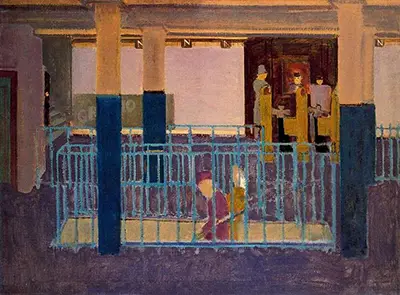Entrance to Subway
Subways were mostly the theme behind Rothko’s works. On moving to New York, he made his art work a depiction of its subways. He got to be inspired by Milton Avery who did colour painting. Entrance to subway is a reminiscent of Avery’s work. Besides, it depicts the lone life of New York subways that gave the painting a depression view.
Setting
Entrance to subway is a painting done during the revolution against socialism and Rothko took the abstract expression way to express the alienated urban environment. This was in 1938 when social realism painting was at its peak and most museums that displayed art were for the realism policy. However, Rothko rejected the depiction of city life realism and opted to tell its emotional vibe through colour.
This particular painting creates a striking mood through the thin human figures who appear so mute and defeated. This was Rothko’s social environment in his thirties, a shapeless and dull hades.
Style
Mark Rothko sophisticated his use of colour on this painting to bring out the daunting atmosphere of the subway. Closer look on the painting, anyone can see the faceless human figures that could be the subway workers or travelers. The images had no eye contact creating the impression of no life. Besides, this painting brings out his emotion of loneliness and isolation that people in the subway had as there was no meaningful connection.
Furthermore, the subway took sketchy figures that showed the soulless New York subway giving it a depression echo. Rothko’s technique of using his paintbrush with oil and acrylics to show emotion can be accorded.
Inspiration
His career muse picked up later when he went for the colour block field. Though Milton Avery seemed to inspire his works in the way he played with his brush strokes. Primitive art influenced his use of colour and need to depict humanity disconnection through emotion. Avery had a profound impact on Rothko as he also kept distance from surrealist paintings.
Most of the artworks that Rothko did started with colour to show human emotions. In the 1930s he got his mentor, the painter Milton Avery who had muse on primitive art. This gave his inspiration for his self-expressed paintings with content figures.
Mark Rothko is an influence to modern artists who use luminous colours and forms to depict scenes, The colour field paintings can be seen in museums and art galleries demonstrating his outstanding accomplishments.


